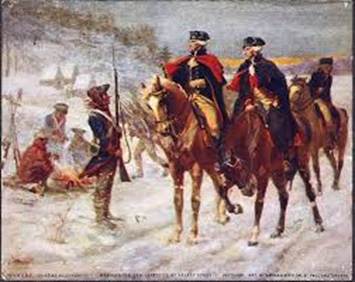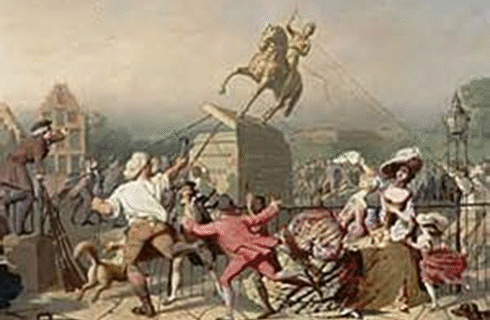Trained in the French Military, he was a descendant of one of the oldest French families, with ancestors who fought alongside of Joan of Arc, and previously fought in the Crusades against Muslim occupiers of what had been the Christian Middle East.

Commander-in-Chief George Washington appointed Lafayette

Returning to France, Lafayette worked with Ben Franklin to persuade King Louis the Sixteenth to send General Rochambeau with ships and 6,000 French soldiers to America’s aid.
Lafayette led troops against the traitor Benedict Arnold. He also commanded at Yorktown, helping to pressure Cornwallis to surrender. On October 19, 1781, British General Cornwallis surrendered.

After the war, Washington wrote a belatedly note to Lafayette from Mount Vernon, June 25, 1785: “My Dear Marquis, I stand before you as a culprit: but to repent and be forgiven are the precepts of Heaven: I do the former, do you practice the latter, and it will be participation of a divine attribute. Yet I am not barren of excuses for this seeming inattention; frequent absences from home, a round of company when at it, and the pressure of many matters, might be urged as apologies for my long silence. I now congratulate you, and my heart does it more effectually than my pen, on your safe arrival in Paris, from your voyage from this Country.”
Lafayette named his son after George Washington – “Georges Washington Louis Gilbert de La Fayette.”
Lafayette joined the French abolitionist Society of the Friends of the Blacks, which advocated the end of the slave trade and equal rights for blacks. Lafayette’s plan to emancipate all slaves was thought impossible by some. Lafayette replied: “If it be a wild scheme, I had rather be mad in this way, than to be thought wise in the other tasks.”
Washington encouraged Lafayett
In the later years of his life, Washington attempted to take four of the farms on his plantation and make them into rental properties, thus transitioning away from slavery.
On May 10, 1786, George Washington wrote from to Marquis de Lafayette: “Your late purchase of an estate in the colony of Cayenne, with a view of emancipating the slaves on it, is a generous and noble proof of your humanity. Would to God a like spirit would diffuse itself generally into the minds of the people of this country.”
On August 15, 1787, in a letter from Philadelphia to the Marquis de Lafayette, George Washington wrote: “I am not less ardent in my wish that you may succeed in your plan of toleration in religious matters. Being no bigot myself to any mode of worship, I am disposed to indulge the professors of Christianity in the church with that road to Heaven which to them shall seem the most direct, plainest and easiest, and the least liable to exception.”
On May 28, 1788, George Washington wrote to Marquis de Lafayette regarding the U.S. Constitution: “A few short weeks will determine the political fate of America. I will confess to you sincerely, my dear Marquis; it will be so much beyond any thing we had a right to imagine or expect eighteen months ago, that it will demonstrate as visibly the Finger of Providence, as any possible event in the course of human affairs can ever designate it.” (So, that shows what Washington thought about the adoption of our Constitution.)
When the French Revolution began, President Washington wrote to Marquis de Lafayette, July 28, 1791: “I assure you I have often contemplated, with great anxiety, the danger to which you are personally exposed with that French Revolt. To a philanthropic mind the happiness of 24 millions of people cannot be indifferent; and by an American, whose country in the hour of distress received such liberal aid from the French, the disorders and incertitude of that Nation’s present state are to be particularly lamented. We must, however, place a confidence in that Providence who rules great events, trusting that out of confusion He will produce order, and, notwithstanding the dark clouds which may threaten at present, that right will ultimately be established.
Washington continued: On the 6 of this month I returned from a tour through the southern States, which had employed me for more than three months. In the course of this journey I have been highly gratified in observing the flourishing state of the Country, and the good dispositions of the people. Industry and economy have become very fashionable in these parts, which were formerly noted for the opposite qualities, and the labors of man are assisted by the Blessings of Providence.”
The French Revolution spiraled into a bloody Reign of Terror. King Louis the Sixteenth and Queen Marie Antoinette were beheaded in 1793.
Lafayette was imprisoned for five years, with his wife and two daughters choosing to be imprisoned with him. However, when finally Napoleon came into power, he negotiated Lafayette’s release.
On June 10, 1792, from Philadelphia, President Washington wrote to Marquis de Lafayette: “And to the Care of that Providence, whose interposition and protection we have so often experienced, do I cheerfully commit you and your nation, trusting that He will bring order out of confusion, and finally place things upon the ground on which they ought to stand.”
Upon the incredible purchase of the huge Lousiana Territory from Napoleon, President Jefferson asked Lafayette to be the Governor of the Louisiana Territory, but he declined.
Fifty years after the American Revolution began, Marquis de Lafayette visited America again. He traveled over 6,000 miles to 24 States. While on his six month tour of America, Lafayette praised: “The grandeur and prosperity of those happy United States, who, at the same time they nobly secure the complete assertion of American independence, reflect, on every part of the world, the light of a far superior political civilization.”
He admired:
“The national love of liberty of a virtuous resistance to oppression, and institutions founded on the rights of man, and the republican principle of self-government.”
On June 17, 1825, Lafayette helped lay the cornerstone for the Bunker Hill Monument.

Beginning with Fayetteville, North Carolina, numerous cities, counties, streets, parks, and ships were named after Lafayette.
Lafayette died in Paris, May 20, 1834.
When word came to America that Marquis de Lafayette had died, President Andrew Jackson wrote to Congress, June 21, 1834: “The afflicting intelligence of the death of the illustrious Lafayette has been received by me this morning. I have issued the general order inclosed to cause appropriate honors to be paid by the Army and Navy to the memory of one so highly venerated and beloved by my countrymen, and whom Providence has been pleased to remove so unexpectedly from the agitating scenes of life.”
In 2002, Marquis de Lafayette was posthumously awarded honorary United States citizenship.
While back in the United States, Lafayette visited the Brandywine battlefield where he had fought alongside of George Washington in 1777. While there, he filled a large trunk with American soil, stating that he wanted it put on his grave in Paris. After his death, his son, “Georges Washington Louis Gilbert de La Fayette,” fulfilled his father’s wish.




